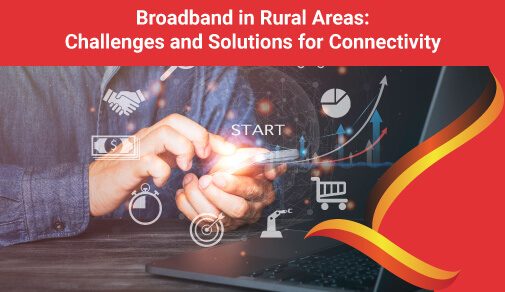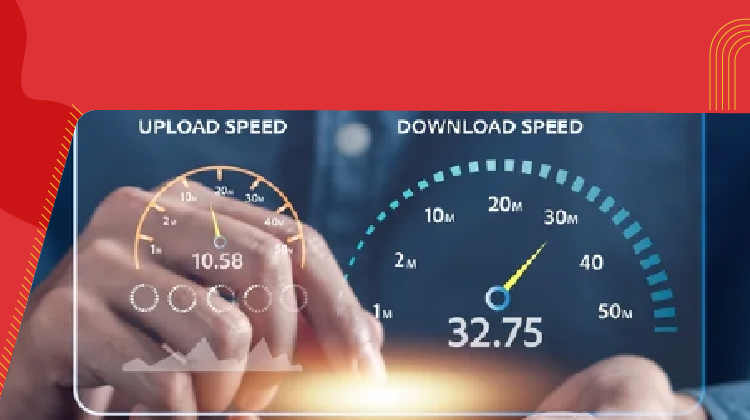Broadband in Rural Areas
Monday, Mar 18, 2024 · 7 minutes


BROADBAND IN RURAL AREAS
Monday, Mar 18, 2024 · 7 minutes
It is simple to provide internet connectivity in crowded urban areas. Numerous service providers, fibernet connections, cable internet, and other options are available.
It's a different issue, though, when it comes to giving rural areas internet access. Internet service companies that serve rural people must overcome certain unique hurdles. We must comprehend the nuances of this digital divide as well as the continuous struggle in rural areas to have a dependable Internet.
Prior to discussing the significance of providing fibernet internet to rural areas, it is critical to comprehend the notion of the digital divide and the factors that contribute to it. The disparity in internet access and usage among various demographic groups or geographic locations is referred to as the "digital divide." Numerous elements, such as infrastructure, education, geography, and economic position, are at the basis of this division. Although most urban areas have \, rural areas frequently have restricted access since it is more expensive and logistically difficult to provide internet services in less populous areas. There aren't many options when it comes to infrastructure issues and setting up internet connections for residences and companies.
The three basic possibilities are fiber, satellite/DSL, and coax; however, the primary objective of these networks was never meant to be internet provision, and their deployment can be incredibly costly and time-consuming. Furthermore, the majority of these systems are designed to service heavily populated areas; rural areas are frequently left till later in the design phase for system extension projects. Providing secure internet access to isolated and rural regions where fiber has not yet reached presents the next challenge. Fixed wireless can help in this situation by providing a solution made especially for direct internet connections via both licensed and unlicensed radio frequencies. But fixed wifi has a unique assortment of difficulties. These consist of the requirement for an unobstructed line of sight, bandwidth constraints resulting from available frequency ranges, and possible disturbance. Therefore, even if fixed wireless could be a useful tool, its use is restricted to particular settings. Fibernet provides reduced latency, increased speed, and interference mitigation. Also, fixed wireless is getting to the stage where it can give speeds equivalent to fiber, which was previously thought to be impossible, thanks to ongoing developments.
We will navigate the difficulties and provide any impending solutions via the blog.
Physical obstacles and the environment provide more difficulties in rural places. The development of internet infrastructure in rural areas can face challenges due to the unique topographical features of these settings. Similar to this, installing wireless access points and running cables can be tough in areas with high elevation, long distances, and rough topography, like mountains or forests. The difficulties in providing reliable internet connectivity also vary with the seasons. A low population and large distances between homes are typical characteristics of rural settings. Because of this, installing and maintaining traditional broadband infrastructure—such as fiber optic cables—becomes more difficult and may not be financially advantageous.
In remote locations, the cost of installing and maintaining broadband infrastructure is relatively high. The main causes of this cost are the requirement for massive networks of satellite technology, cellular towers, and fibernet optic cables. For example, setting up Fibernet, a high-speed internet connection in rural locations, is very expensive and logistically challenging. The main obstacle to increasing rural internet options is the high cost of infrastructure development because it reduces the potential for profitability and may make private enterprises reluctant to invest in areas with small client bases. Developing internet infrastructure in rural areas also presents a number of logistical challenges. The process can be laborious and time-consuming because of the great distances between villages, remote sites, and the requirement for specialised staff and equipment.
Maybe it's harder to detect this challenge than the other difficulties. Most internet service providers are private, profit-driven businesses. Because there are so many potential clients in rural America, they are more cautious when making investments there. It is challenging for areas with low concentrations of people per square area to attract big broadband providers to their communities because every major ISP is focused on maximising profit. Even when remote areas contact large ISPs, they are typically provided Data Sticks and Wi-Fi, which are expensive and don't ensure high-speed internet access.
The majority of rural populations are growing increasingly dissatisfied with their rural internet reality. Nevertheless, there aren't many good substitutes because the ones that are readily available frequently have issues with dependability, cost, and even dubious behaviour like internet throttling. Most DSL providers in rural areas don't guarantee their speeds. Depending on how far you live from the phone company hub, DSL internet speeds might vary greatly, resulting in erratic and frequently slow connections. Because satellite Internet has significant latency and ping rates, it is unpredictable and slow. This can be very annoying when playing online games. The strength of your satellite signals might also be impacted by weather variations like strong thunderstorms or periods of intense rain.
It can be challenging to establish a dependable internet connection in rural locations due to a lack of adequate network coverage. In addition, physical barriers like hills, forests, or isolated areas might make it more difficult to implement conventional network infrastructure.
A lot of rural communities struggle with erratic electricity supplies. For internet infrastructure, setting up and keeping up a steady power supply can be very difficult.
Innovations are opening doors for creative approaches to the problems rural locations face. For example, using unmanned aircraft, inflated objects, and satellites as alternative equipment can help get past the logistical and physical challenges that come with living in a rural region.
Furthermore, the amalgamation of technologies like cloud computing, IoT, 5G, and AI is poised to transform rural wireless connectivity. The development of smart rural areas—where uses like remote healthcare, precision agriculture, and distance learning can be realised—will be made possible by these technologies. Beyond just the technology itself, this shift affects a number of economic areas and improves the usefulness and productivity of apps in the fields of agriculture, healthcare, and education. Even though there are many moving parts involved in rural internet issues, there are a few potential solutions that could help underserved rural areas get consistent connectivity:
Increasing internet connection in remote areas requires government support, such as the Universal Service Fund. The financial barrier to infrastructure expansion can be addressed by the government by offering subsidies or allocating resources to incentivize ISPs to invest in rural areas.
Working together, the public and private sectors can lessen the financial strain of developing infrastructure in rural areas. This is a proactive strategy to create accessible fibernet internet plans in rural India. In order to guarantee extensive internet connectivity in rural areas, this partnership model makes use of both public resources and private sector knowledge.
Utilising satellite internet and mobile networks might offer affordable options for rural connection. Where traditional infrastructure is impracticable, satellite internet can provide coverage, and mobile technologies like 4G and 5G can more easily reach rural places. The issue of power supply can be resolved by putting off-grid options, like solar-powered base stations, into practice. With this strategy, internet infrastructure is guaranteed to continue functioning even in locations with unstable electrical grids. The implementation of technologies tailored for rural settings, like mesh networks and TV White Spaces, can enhance connectivity and adjust to the distinct difficulties presented by these terrain.
In remote places, having access to high-speed internet has changed from being a luxury to becoming a necessity. Small companies can use it to swipe cards and it is operational. Regrettably, given the financial burden on the Providers, most of rural India still has inadequate internet access from the main ISPs. Nevertheless, the financial consequences of handling rural internet surpass the expenses involved.
In order to close the digital divide and give rural people access to job possibilities, schooling, and increased digital competence, it is imperative that fiber internet connectivity be extended to these areas. Leading the way in India, ACT Fibernet collaborates diligently with local authorities and leaders of the community on a daily basis to build a more just and equitable digital environment for everybody. It is now simpler for rural communities to take advantage of lightning-fast internet connections and overcome the restrictions of rural internet options in these places thanks to cost-effective seamless internet bundles and excellent customer care. Whether you require service in urban or rural areas, we'll design a specially made wireless system that enables you to provide dependable, fast internet to your clients.
Speak with one of our rural broadband specialists right now!
90

The New Social: How High-Speed Internet is Redefining 'Quality Time' with Friends and Family
Read more333

How ACT SmartWi-Fi is Redefining Home Internet in 2025: The Age of AI-Powered Seamless Connectivity
Read more132

From Bandwidth to Intelligence: How AI Is Redefining Business Demands from ISPs
Read more
A referral link has been sent to your friend.
Once your friend completes their installation, you'll receive a notification about a 25% discount on your next bill
![]() Please wait while we redirect you
Please wait while we redirect you

![]() One of our representatives will reach out to you shortly
One of our representatives will reach out to you shortly

One of our representatives will reach out to your shortly
![]() Please wait while we redirect you
Please wait while we redirect you

Please enter your registered phone number to proceed

Please enter correct OTP to proceed


Dear customer you are successfully subscribed
Please wait while we redirect you

Your ACT Shield subscription has been successfully deactivated

Dear user, Your account doesn't have an active subscription

Dear customer Entertainment pack is already activated.
Please wait while we redirect you